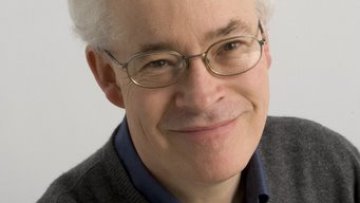Duality of Wilson loop form factors
Abstract
We find a new duality for form factors of lightlike Wilson loops
in planar N=4 super-Yang-Mills theory. The duality maps a form factor
involving a lightlike polygonal super-Wilson loop together with external
on-shell states, to the same type of object but with the edges of the
Wilson loop and the external states swapping roles. This relation can
essentially be seen graphically in Lorentz harmonic chiral (LHC) superspace
where it is equivalent to planar graph duality.
Multiple zeta values in deformation quantization
Abstract
In 1997, Maxim Kontsevich gave a universal formula for the
quantization of Poisson brackets. It can be viewed as a perturbative
expansion in a certain two-dimensional topological field theory. While the
formula is explicit, it is currently impossible to compute in all but the
simplest cases, not least because the values of the relevant Feynman
integrals are unknown. In forthcoming joint work with Peter Banks and Erik
Panzer, we use Francis Brown's approach to the periods of the moduli space
of genus zero curves to give an algorithm for the computation of these
integrals in terms of multiple zeta values. It allows us to calculate the
terms in the expansion on a computer for the first time, giving tantalizing
evidence for several open conjectures concerning the convergence and sum of
the series, and the action of the Grothendieck-Teichmuller group by gauge
transformations.
17:30
Differentiability of functions definable in C-minimal valued fields
Abstract
We consider the differentiability of definable functions in tame expansions
of algebraically closed valued fields.
As the Frobenius inverse shows such a function may be nowhere
differentiable.
We prove differentiability almost everywhere in valued fields of
characteristic 0
that are C-minimal, definably complete and such that, in the valuation
group,
definable functions are strongly eventually linear.
This is joint work with Pablo Cubides-Kovacsics.
Oxford Mathematician Nick Trefethen FRS has been awarded the prestigious George Pólya Prize by the Society for Industrial and Applied Mathematics (SIAM). The Prize for Mathematical Exposition, established in 2013, is awarded every two years to an outstanding expositor of the mathematical sciences.
Using ideas from statistics for analysing (spatio-temporal) stochastic processes
Abstract
Many systems in nature consist of stochastically interacting agents or particles. Stochastic processes have been widely used to model such systems, yet they are notoriously difficult to analyse. In this talk I will show how ideas from statistics can be used to tackle some challenging problems in the field of stochastic processes.
In the first part, I will consider the problem of inference from experimental data for stochastic reaction-diffusion processes. I will show that multi-time distributions of such processes can be approximated by spatio-temporal Cox processes, a well-studied class of models from computational statistics. The resulting approximation allows us to naturally define an approximate likelihood, which can be efficiently optimised with respect to the kinetic parameters of the model.
In the second part, we consider more general path properties of a certain class of stochastic processes. Specifically, we consider the problem of computing first-passage times for Markov jump processes, which are used to describe systems where the spatial locations of particles can be ignored. I will show that this important class of generally intractable problems can be exactly recast in terms of a Bayesian inference problem by introducing auxiliary observations. This leads us to derive an efficient approximation scheme to compute first-passage time distributions by solving a small, closed set of ordinary differential equations.
17:00
The Struggle for Algebra: English mathematics around 1660
Abstract
Part of the series "What do historians of mathematics do?"
The talk will set out the key debate in England at the Restoration, the need for a new orientation in mathematics towards algebra and the new "analysis". It will focus on efforts by three central players in England's mathematical community, John Pell, John Collins, and the Oxford mathematician John Wallis to produce an English language algebra text which would play a pioneering role in promoting this change. What was the background to the work we now call Pell's Algebra and why was it so significant?
17:00
Ars sine Scientia Nihil Est: Architecture and Mathematics through history
Abstract
Part of the series "What do historians of mathematics do?"
In the last year of 14th century, a French mathematician/geometer Jean Mignot, was called from Paris to help with the construction of the Cathedral of Milan. Thus was created one of the most famous stories about how mathematics literally supports great works of art, helping them stand the test of time. This talk will look at some patterns that begin to become apparent in the investigations of the relationship between architecture and mathematics and the creativity that is common to the pursuit of both. I will present the case on how this may matter to someone who is interested in the history of mathematics. To make this more intelligible, I will partly talk also of my personal journey in investigating this relationship and the issues I have researched and written about, and how these in turn changed my view of the nature of mathematics education.


